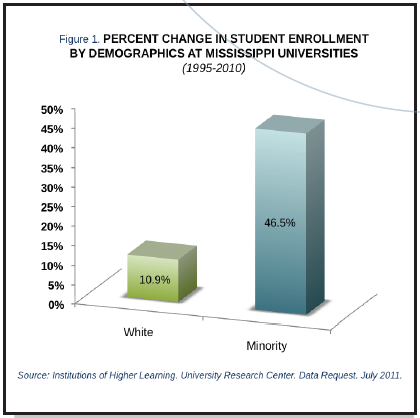Mississippi’s Colleges and Universities Now Enroll More Students. Who Are They?
December 26th, 2013
 Last time, I talked about financial aid within Mississippi, particularly focusing on how important it is for both persistence and graduation outcomes. With this post I will continue discussing MEPC’sInvesting In Our Future report by highlighting some of the college students who are most affected by financial aid. Specifically, we will explore some of the challenges faced and provide context as to why financial aid is the variable that often defines a college student’s success.
Last time, I talked about financial aid within Mississippi, particularly focusing on how important it is for both persistence and graduation outcomes. With this post I will continue discussing MEPC’sInvesting In Our Future report by highlighting some of the college students who are most affected by financial aid. Specifically, we will explore some of the challenges faced and provide context as to why financial aid is the variable that often defines a college student’s success.
Mississippi’s higher education institutions have rapidly enrolled more students over the past decade. University enrollment grew by approximately 25% or 12,000 students, while the community college system grew by approximately 30,000 more students. This growth also encapsulates how diverse Mississippi’s college campuses have become. Between 1995 and 2010, non-white students accounted for three quarters of the enrollment increase at the university level. For community colleges, African-Americans compose 42% of total enrollment. Figure 1 further highlights how profound these changes have become. Enrollment rates among minority students at universities have increased by more than four times the rate of white students since 1995. The vast majority of this increase is represented by African-American students.
The harsh reality, however, is that more than half of Mississippi’s African-American children grow up in conditions of poverty. Economic hardship heavily influences whether or not a student finishes a high school education – college completion is even further impacted. Thus, while minority students are enrolling at the university and community college level at much faster rates, those students from economically secure households are much more likely to graduate. Students who are not able to finish their studies often find themselves dropping out not because they are unable to meet the academic demands of college, but instead because the financial stressors prove to be insurmountable. Thousands of Mississippi students are making the grade, but leave college due to lack of resources.
How can Mississippi change this reality? More state financial aid is key, especially considering that the federal Pell Grant now covers its smallest share of college costs since the program’s inception. If we are to see significant gains in college completion, however, increased financial aid must be pointed toward low-income students. This group faces the most hurdles, but only has 15% of Mississippi’s financial aid allocated based on need. With our next post, we’ll explore some policy recommendations that address these disparities and present effective paths forward.






